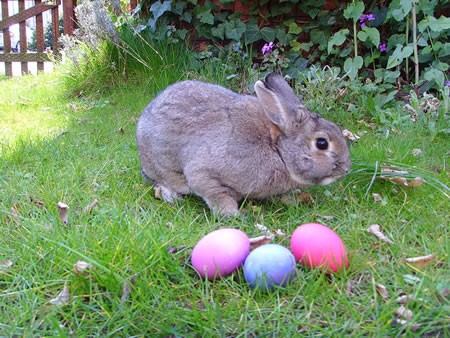The Easter Bunny is a curious symbol of Easter. Just how did this egg
laying bunny come to be immortalized in chocolate and placed into nearly
every child's Easter basket?

The Easter Bunny
The Easter Bunny is one of the most beloved symbols of Easter. Over centuries, the rabbit has always represented fertility and, thus, spring. In fact, the rabbit is often associated with the goddess, Ēostre. And, it is from her name that the word “Easter” is thought to have evolved. It was, however, in Germany that the Easter Bunny was conceived. Joseph Grimm, of the infamous Brother's Grimm who collected and recorded such fairy tales as Little Red Riding Hood and Hansel and Gretel, wrote of the myth of the Easter Bunny in 1835, although mention of the Easter Bunny has been traced to German writing in the 1600's. Germany was also the birthplace of those delectable edible Easter bunnies we all love today. When Germans immigrated to Pennsylvania, they brought with them not only the edible bunnies but also the tale of Osterhase, a rabbit who would lay brightly colored eggs in “nests”, created by children with their bonnets and caps, hidden in the home. But, only if the children had behaved themselves!


The Easter Bunny
The Easter Bunny is one of the most beloved symbols of Easter. Over centuries, the rabbit has always represented fertility and, thus, spring. In fact, the rabbit is often associated with the goddess, Ēostre. And, it is from her name that the word “Easter” is thought to have evolved. It was, however, in Germany that the Easter Bunny was conceived. Joseph Grimm, of the infamous Brother's Grimm who collected and recorded such fairy tales as Little Red Riding Hood and Hansel and Gretel, wrote of the myth of the Easter Bunny in 1835, although mention of the Easter Bunny has been traced to German writing in the 1600's. Germany was also the birthplace of those delectable edible Easter bunnies we all love today. When Germans immigrated to Pennsylvania, they brought with them not only the edible bunnies but also the tale of Osterhase, a rabbit who would lay brightly colored eggs in “nests”, created by children with their bonnets and caps, hidden in the home. But, only if the children had behaved themselves!

Easter Baskets
What are you hoping to find in your Easter basket this year? A chocolate bunny, jellybeans, M&M's, chocolate eggs, PEEPS® Marshmallow Chicks? Easter baskets weren't always filled with candy treats. In fact, Easter baskets were first used by Catholics, who carried food to mass to be blessed prior. Easter bonnets were used in a similar fashion. And, long before this Catholic tradition, it was traditional to take a basket seedlings to making an offering to the goddess, Ēostre. She herself was often depicted carrying a basket of eggs.
What are you hoping to find in your Easter basket this year? A chocolate bunny, jellybeans, M&M's, chocolate eggs, PEEPS® Marshmallow Chicks? Easter baskets weren't always filled with candy treats. In fact, Easter baskets were first used by Catholics, who carried food to mass to be blessed prior. Easter bonnets were used in a similar fashion. And, long before this Catholic tradition, it was traditional to take a basket seedlings to making an offering to the goddess, Ēostre. She herself was often depicted carrying a basket of eggs.
Немає коментарів:
Дописати коментар